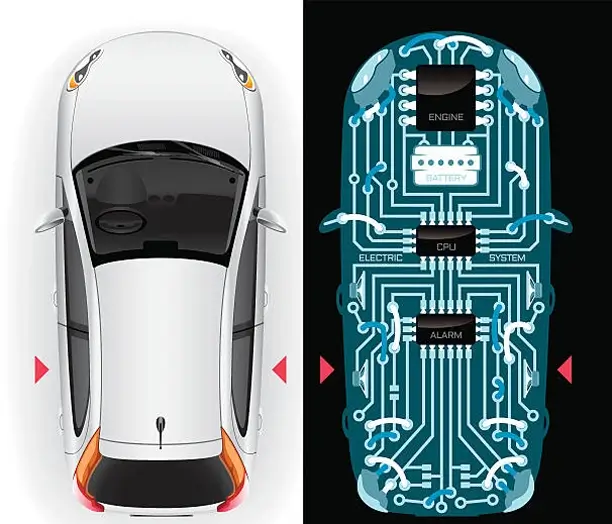Automotive PCB
automotive PCB Introduction
Automotive PCBs, tailor-made for vehicular use, are instrumental in elevating both the safety and functionality of automotive technologies. These boards provide a robust foundation for mounting and interlinking electronic circuits across a myriad of automotive systems, from advanced driver assistance systems (ADAS) to entertainment and lighting. Engineered to surpass the durability of standard commercial PCBs, automotive PCBs are built to endure the rigors of extreme automotive environments, catering to the evolving complexity of vehicle electronics.

Automotive PCB Applications
Automotive PCBs are foundational to the electronics of modern vehicles, impacting virtually all automotive systems. Common Automotive PCB applications span various segments of the automotive industry, such as:
- Airbag Controls
- Anti-lock Brake Systems
- Anti-theft Systems
- Audio/Video Systems
- Security Systems
- Smart Keys
- Rear-view Cameras
- Power Distribution Systems
- Transmission Sensors
- Signals and Lamp Controls
- Windshield Wipers
- Power Converters
- Fluid Monitors
- Digital Displays
- Engine Timing Systems
- Ignition Systems
- Power Steering
- On-board and Remote Diagnostics
In today’s automobiles, the diversity of electronic systems is vast, driving the need for a wide range of PCB types. With consumers increasingly seeking enhanced features and accessories powered by electronics, the demand for various automotive PCBs continues to surge.

The critical role of automotive PCBs in vehicle safety and performance
Automotive PCBs have a significant role in enhancing the safety of modern vehicles, such as:
Airbags: Automotive PCBs are pivotal in airbag deployment systems, analyzing sensor data to timely deploy airbags during collisions.
ADAS (Advanced Driver-Assistance Systems): Essential for reducing car accidents, ADAS relies on automotive PCBs to process data and trigger various safety alerts.
Anti-Lock Braking Systems (ABS): Integral in modern vehicles, ABS uses PCBs to improve braking response and maintain vehicle control during stops.
Electronic Stability Control (ESC): Automotive PCBs are utilized in ESC systems to monitor steering angles, wheel speed, and acceleration, enhancing vehicular stability.
Vehicle Communication Networks: PCBs play a crucial role in managing the communication networks within a car, supporting various safety systems.
Fuel Injection Control: Engine control PCBs dictate the timing and quantity of fuel injection, optimizing power output and engine efficiency.
Shock Load and Engine Vibration Management: While indirectly involved, automotive PCBs govern suspension systems that mitigate engine vibrations and shock impacts.
Engine and Gear Control: Engine control PCBs oversee various engine functions, including fuel injection and ignition timing, while also managing automatic transmission and gear shifts.
In addition to the examples provided, automotive PCBs can also be found in other features such as digital displays, radar systems, GPS systems, power relays, and timing systems, all aimed at augmenting vehicle functionality and enhancing efficiency and safety.
Automotive PCB Standards
Manufacturers involved in producing, assembling, and transporting printed circuit boards for the automotive industry must adhere to rigorous standards and specifications. They are required to supply circuit boards made from materials that can endure harsh conditions, ensuring reliability, stability, and safety within vehicle electronic systems. Several prevalent automotive PCB standards include:
IPC-A-600G
This benchmark sets the standards for PCB design, addressing visual aspects, dimensions, configurations, and surface details, and is applicable across a wide range of PCBs, especially for automotive use.
ISO 26262
Targets automotive functional safety across the lifecycle, demanding stringent safety protocols in PCB design, production, and implementation.
UL 94
Evaluates the flammability of plastics in PCBs to ensure compliance with automotive fire safety standards.
IEC 61508
Provides a framework for functional safety in automotive systems, requiring safety considerations at every development and manufacturing phase of PCBs.
JESD22-A100
Specifies environmental stress testing for electronic components, using humidity, temperature, and vibration assessments to ensure automotive PCB endurance.
RoHS
Limits hazardous substances in automotive PCBs, ensuring environmental and health safety standards are met.
AEC-Q100/AEC-Q200
Sets the benchmark for the reliability and environmental resilience of automotive electronic components, focusing on temperature resilience and durability.
ISO/TS16949
As a technical regulation for the global automotive industry, it incorporates the special requirements of the automotive industry and focuses on defect prevention, quality fluctuations and waste reduction in the automotive parts supply chain.
Automotive PCB Manufacturing Challenges and Their Solutions
Technological Innovations: The rapid pace of technological advancements in PCB manufacturing poses challenges for some manufacturers in keeping up with new innovations. Companies can stay competitive by investing in employee training to align with modern technological expectations and demands.
High Reliability: The durability of automotive PCBs is crucial, demanding a service life of 10 to 12 years, similar to vehicles themselves. They must withstand extreme environmental conditions like temperature variations, humidity, acid smoke, vibration, and electromagnetic interference, necessitating the use of robust materials and designs that ensure consistent performance across diverse climates.
Meeting Automotive PCB Standards: In the automotive sector, adherence to stringent quality standards is non-negotiable due to the direct correlation between PCB performance and vehicle safety. To meet these high-quality demands, manufacturers are increasingly relying on automated assembly processes to enhance the precision and reliability of PCBs.
Lightweight and Miniaturization: The complexity of PCBs, due to their tiny components and the requirement to fit into compact spaces within vehicles, necessitates meticulous manufacturing inspections. Emphasis on miniaturization and lightweight designs contributes to fuel efficiency improvements, evidenced by the significant reduction in the volume of automotive-applied ECUs over the years. These advancements result from enhanced density, reduced area, thinner profiles, and the adoption of multilayer structures.
Automotive PCB Design Considerations
Automotive PCBs adhere to strict design principles and undergo thorough analysis to satisfy rigorous reliability criteria.
Inductor Orientation: To minimize crosstalk and undesirable electromagnetic coupling, inductors on the PCB should be placed with precision, ensuring they are adequately spaced and oriented orthogonally to one another to prevent interference between inductors and coils.
Trace Coupling: Optimizing the PCB stackup and layout to ensure traces follow their return paths can significantly reduce noise pickup and radiation, particularly for sensitive analog signals, thereby improving overall signal quality through careful route planning.
Grounding Vias: The strategic positioning of ground vias close to components can greatly reduce ground loop inductance, ensuring stable reference planes. Employing multiple vias can also help in managing temperature rise and maintaining signal integrity.
Ground Planes and Signal Integrity: Effective PCB ground structures are essential for providing a low-impedance path and should include adequate copper fill connected by vias to mitigate electromagnetic interference and maintain signal integrity, especially at high frequencies. Techniques such as IBIS modeling should be used to simulate and verify signal performance under various environmental conditions, with optimizations in trace dimensions and routing for high-quality signal transmission and controlled impedance routing for high-speed data buses.
Thermal Management: Addressing the heat generated by power devices within the PCB layout is critical and requires thermal simulation, possibly through finite element analysis, along with the incorporation of thermal vias, heat sinks, and cooling measures. Components should be automotive-grade and rated for extended temperature ranges, with materials like polyimide chosen for their higher temperature tolerance and thermal vias or slots included for efficient heat dissipation.
- Reliability Testing and Safety Standards:
Compliance with AEC-Q100 and AEC-Q101 for industry-standard validation.
Execution of accelerated durability tests, including temperature cycling, humidity, and Highly Accelerated Stress Screening (HASS).
Conformity with the ISO 26262 Functional Safety standards for automotive safety.
Adherence to minimum clearance and creepage requirements as specified in ISO 6469-3.
Parts qualification through rigorous testing per the AEC-Q101 standard.
CONTACT US
For customers who require new products with complex circuit boards and have tight release schedules, we provide technology and expertise from prototype to production. You can contact us through the methods below to discuss your project with our technical experts immediately. We will be in touch within 24 Reply within hours.
If you already have documentation for your PCB or PCBA related needs, please submit a quick quote for a free evaluation.


